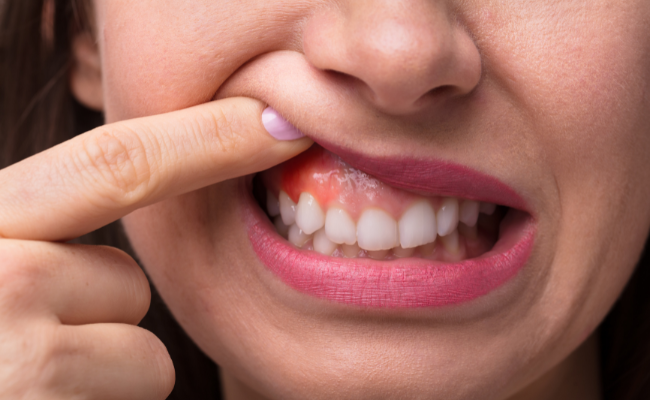How to Treat Bleeding Gums?
- October 27, 2023
- No Comments

What is Bleeding Gums?
Bleeding gums, a common dental issue experienced by many at some point in their lives, occur when the gums become inflamed and sensitive, leading to the release of blood, particularly during routine activities like brushing or flossing. While gum disease is a frequent cause, various factors such as poor oral hygiene, hormonal changes, vitamin deficiencies, or specific medical conditions contribute to this concern.
Beyond being a primary indicator of gum disease, bleeding gums may also signal underlying health issues. Intermittent gum bleeding can result from overly vigorous tooth brushing or the use of ill-fitting dentures. Recognizing bleeding gums as both a dental matter and a potential signal of broader health implications is crucial for comprehensive care.
Why Bleeding Gums occurs?
One of the main culprits behind bleeding gums is gingivitis, the early stage of gum disease. Gingivitis is caused by the accumulation of plaque—a sticky film of bacteria—on the teeth and gums. When not adequately removed through regular brushing and flossing, this plaque can irritate the gums, causing inflammation and, eventually, bleeding.
Other factors contributing to bleeding gums include hormonal changes, such as those during pregnancy, menstruation, or menopause. These changes can make gums more susceptible to inflammation. Additionally, vitamin deficiencies, especially in vitamin C (scurvy), can lead to weakened blood vessels in the gums, making them more prone to bleeding.
Certain medical conditions, like blood clotting disorders or leukemia, may also manifest with bleeding gums. Furthermore, using a hard-bristled toothbrush or brushing too vigorously can damage the delicate gum tissue, resulting in bleeding.
How to Manage and Prevent Bleeding Gums?
- Improved Oral Hygiene: The most fundamental step in treating and preventing bleeding gums is maintaining proper oral hygiene. Regular brushing, preferably with a soft-bristled toothbrush, and flossing help remove plaque and bacteria, reducing the risk of gum inflammation.
- Regular Dental Checkups: Scheduling regular dental checkups is crucial for early detection of gum issues. Dentists can identify signs of gingivitis or gum disease in their early stages and provide appropriate guidance for treatment.
- Gentle Brushing Techniques: Adopting gentle brushing techniques is essential to avoid damaging the gums. Use a soft-bristled toothbrush and brush in a circular motion, applying gentle pressure. Avoid aggressive brushing that may cause irritation.
- Flossing: Flossing is often neglected but is crucial in preventing gum disease. It helps remove plaque and debris from between the teeth and along the gumline, areas that a toothbrush may not reach effectively.
- Antibacterial Mouthwash: Using an antibacterial mouthwash can help reduce bacteria in the mouth, promoting gum health. Choose a mouthwash with antimicrobial properties to target the bacteria contributing to gum inflammation.
- Balanced Diet and Supplements: Maintain a balanced diet rich in vitamins and minerals, especially vitamin C, which is essential for gum health. In some cases, supplements may be recommended to address nutritional deficiencies.
- Quit Smoking: Smoking is a significant risk factor for gum disease. Quitting smoking not only improves overall health but also contributes to better gum health, reducing the likelihood of bleeding gums.
Treatment Solutions:
- Scaling and Root Planing: For advanced cases of gum disease, a dentist may recommend scaling and root planing. This deep cleaning procedure removes plaque and tartar from below the gumline and smoothens the tooth roots to prevent further bacterial growth.
- Antibiotics: In cases of infection, antibiotics may be prescribed to eliminate bacteria causing gum inflammation. These can be in the form of oral antibiotics or topical antibiotics applied directly to the gums.
- Dental Procedures: In severe cases, surgical procedures may be necessary to address gum issues. This can include gum grafts to cover exposed tooth roots or periodontal flap surgery to remove tartar deposits in deep pockets.
Benefit Points:
- Prevents Tooth Loss: By addressing bleeding gums promptly, individuals can prevent the progression of gum disease, ultimately reducing the risk of tooth loss. Healthy gums provide essential support to the teeth.
- Enhances Confidence: Bleeding gums can be socially embarrassing and may affect confidence. Treating this issue contributes to improved oral health, leading to a brighter smile and increased self-assurance.
- Prevents Systemic Health Issues: The health of the gums is linked to overall well-being. By preventing and treating bleeding gums, individuals may reduce the risk of systemic health issues associated with untreated gum disease, such as cardiovascular problems or diabetes complications.
- Long-Term Cost Savings: Addressing bleeding gums early on can result in long-term cost savings. Preventing the progression to advanced gum disease reduces the need for extensive and costly dental treatments or surgeries.
- Improved Quality of Life: Maintaining healthy gums contributes to an improved quality of life. Individuals can enjoy pain-free eating, speaking, and overall oral comfort when gum health is prioritized.
Comments (0)